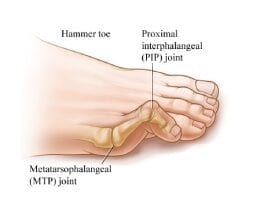Hammertoes
Hammertoes
 A hammertoe is a change in toe position due to contracture of tendons, laxity of ligaments or arthritic change in joints. These generally progress over time and have many causes and presentations. Hammertoes, one of the most painful foot ailments, can often be traced directly to the wearing of narrow, pointed-toe shoes. Women most often are the victims of hammertoes. Most of the time, female footwear is not much wider at the front than at the heel, and the outline of the normal foot is rounded. The combination of narrow shoe and wide foot, of pointed shoe and rounded foot, causes, predictably enough, painful foot problems such as hammertoes.
A hammertoe is a change in toe position due to contracture of tendons, laxity of ligaments or arthritic change in joints. These generally progress over time and have many causes and presentations. Hammertoes, one of the most painful foot ailments, can often be traced directly to the wearing of narrow, pointed-toe shoes. Women most often are the victims of hammertoes. Most of the time, female footwear is not much wider at the front than at the heel, and the outline of the normal foot is rounded. The combination of narrow shoe and wide foot, of pointed shoe and rounded foot, causes, predictably enough, painful foot problems such as hammertoes.
Additionally, there are certain foot shapes that are generally unstable while walking. Overtime this instability can cause the toes to flex to provide additional foot support. The toes contracture over an extended period of time can lead to contracture.
The tip of a hammertoe can strike the ground with a thud at every step and become flat and squat. A hard corn can form on top, and a distal corn can form at the hammering portion. The nail might split or grow inward. A corn or callused nail groove might develop where the flesh is caught between the nail and the toe bone or where the toe is angulated. A soft corn can prove especially annoying when it is between the hammertoe and the adjacent toe that is overlapped. Although any toe may be affected, the second toe suffers most often. It is longer than the other toes and therefore more likely to be deformed by small footgear. The effects of a hammertoe are not limited to the toe. The toe bones, forced back against the metatarsals, exert pressure against the center of the foot. The ball of the foot suffers, calluses form, and muscular cramps develop.
Wearing tight-fitting stockings, short footgear, tapered-toe shoes, pointed-toe shoes, tight leotards, or really snug pantyhose for long periods of time can produce a hammertoe. Because these articles of apparel are necessarily worn on each foot, there can be two hammertoes, one on each foot.
Surgery is sometimes required for this condition. There are many techniques that can be used to correct hammertoes and often times it is fairly simple. Patients almost always walk after surgery and minimal incision techniques greatly reduce discomfort and healing times.
PLEASE NOTE:
The information contained in this article is not intended to provide advice for individual problems, nor to substitute for professional advice or care from a physician. For answers to specific questions concerning your personal circumstances, you should consult your physician directly.
